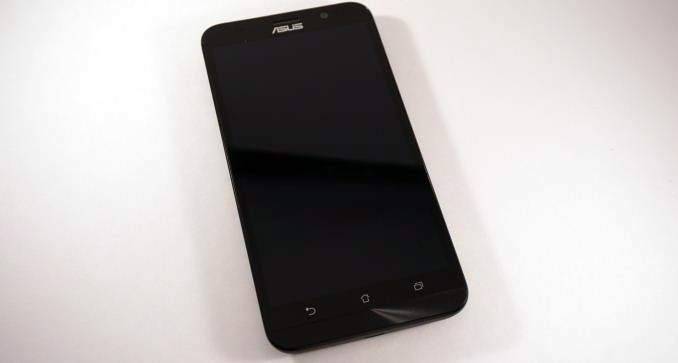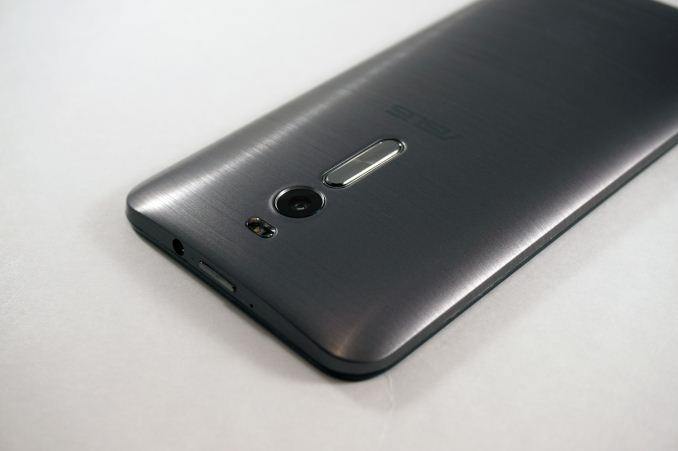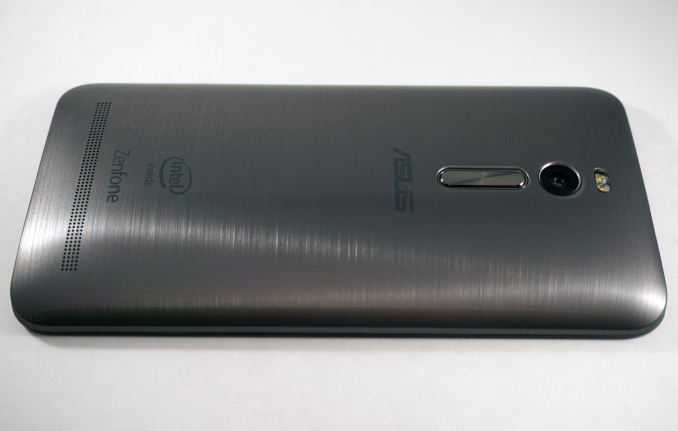The ASUS ZenFone 2 Preview
by Brandon Chester on May 18, 2015 2:00 PM EST
ASUS is not new to the smartphone market. Since the days of Windows Mobile (not the new Windows Mobile) they've been selling smartphones. But when it comes to Android devices they've been primarily focused on tablets. ASUS worked with Google to design and manufacture both generations of the Nexus 7, which was beloved by Android enthusiasts. Their PadFone devices were an attempt to have a smartphone that attached to a tablet shell to make a sort of 2-in-1 smartphone and tablet.
However it's only recently that the company has started making a serious push into what has become the traditional Android smartphone space. In 2014 the company had a fairly successful year in the smartphone space with their first generation of ZenFones, however while APAC sales were good they didn't quite make as big of a dent in the North American market as they could have - and likely not as big as they were hoping, I suspect.
This brings us to today with the North American launch of the ZenFone 2, the second generation ZenFone, and ASUS's second shot at making a major wave in the North American smartphone market. After initially going on sale in ASUS's home country of Taiwan on March 8th, and more recently in Japan and India, today ASUS is bringing over their latest phone to North America, where it will go on sale as an unlocked device through retailers like Amazon and Newegg.
It's hard to say which previous ASUS device the ZenFone 2 is a sequel to. It's actually a bit of an outlier compared to ASUS's earlier Android phones. Starting with the 2015 generation of ZenFones, ASUS has clamped down on the number of models they have released, ditching their broad spectrum of ZenFones in many sizes for fewer, more distinct models. As a result the last-generation ZenFones, the ZenFone 4, the ZenFone 5, and the ZenFone 6, have all been replaced with a single product, the ZenFone 2. The naming is a bit unfortunate in light of ASUS's earlier, sized-based naming scheme, but ultimately the point to take away from all of this is that what we're looking at is the second generation ZenFone. On a generational basis then, it's probably most accurate to call it a successor to the ZenFone 5, as it's similar in screen size and the ZenFone 2 is a natural progression when it comes to specifications.
In North America the ZenFone 2 is the first of ASUS's 2015 ZenFone products to launch, and it is the company's flagship smartphone for 2015. You won't see the budget ZenFone C here, and meanwhile the only other member of the ZenFone family will be the forthcoming ZenFone Zoom. As opposed to being another smartphone, the Zoom will be ASUS's take on a true cameraphone, combining a more complex point & shoot optics system - complete with optical zoom - with a traditional smartphone.
As for today's product launch, much like its 2014 predecessors, ASUS is coming out swinging with very aggressive pricing on the ZenFone 2. With the entry level model coming out at $199 and the most expensive model at $299, at first glance it seems strange to call the ZenFone 2 ASUS's flagship smartphone. At these prices the immediate competition for the ZenFone 2 would appear to be devices like the Moto G and the Lumia 735. But don't let yourself be deceived by the price. The ZenFone 2 has some extremely impressive specifications for a low cost smartphone, launching with a fairly powerful Intel quad-core Atom SoC, 2GB+ of RAM, and a 5.5" 1080p IPS screen. As today's article is just a preview to line up with ASUS's launch I won't spend much time going over them today, but you can take a look at an overview of the ZenFone 2's specs below.
| ASUS ZenFone 2 (Base) | ASUS ZenFone 2 (High-End) | |
| SoC | Intel Atom Moorefield Z3560 4x Silvermont @ 1.8GHz |
Intel Atom Moorefield Z3580 4x Silvermont @ 2.33GHz |
| GPU | PowerVR G6430 @ 533MHz | |
| RAM | 2GB LPDDR3 | 4GB LPDDR3 |
| NAND | 16GB + microSDXC | 64GB + microSDXC |
| Display | 5.5" 1920x1080 IPS LCD | |
| Dimensions | 77.2 x 152.5 x 10.9 mm, 170g | |
| Camera | 13MP Rear Facing with F/2.0 aperture 5MP Front Facing with F/2.0 aperture |
|
| Battery | 3000mAh (11.4Wh) | |
| OS | Android 5.0 Lollipop with ASUS Zen UI | |
| Cellular Connectivity | 2G / 3G / 4G LTE (Intel XMM7262 Category 6 LTE) Second SIM 2G GSM (Intel XMM2230) |
|
| Other Connectivity | 802.11a/b/g/n/ac + BT 4.0, GNSS, NFC, microUSB2.0 | |
| SIM | Dual SIM slots | |
| Price | $199 | $299 |
Since I've only had the phone for a couple of days at this point and haven't had a chance evaluate every last aspect of it, I'm going to divide up our coverage a bit. Lining up with today's formal launch from ASUS, I want to start with some of our more interesting data for our readers who are looking for some quick impressions before pulling the trigger. Meanwhile later this week I'll be back with a full review of the phone, including more benchmarks and a look at other aspects such as the camera and battery life.
In terms of construction and build quality, I like the design of the ZenFone 2. The chassis reminds me a lot of LG's larger phones. It curves to a very thin edge, has very thin bezels, and places the volume rocker beneath the camera on the back of the phone. The materials make it look distinctly like an ASUS product, with a brushed finish that reflects light in interesting ways. Although the back of the ZenFone 2 looks like the brushed aluminum on ASUS's high end laptops, it is made of plastic. I would love if it had an aluminum build, at $199 ASUS is already packing in higher specs than competing phones with similar worldwide availability.
The one aspect of the design that I do consider questionable is the placement of the power button. It's located on the top of the device, next to the 3.5mm audio jack. Even though the ZenFone 2 is fairly small for a 5.5" device, it's difficult to reach up to the top to turn it on without having to shift your grip upward. It's not the end of the world, but I would like to see it moved to the right side of the phone for future ZenFone devices. Despite the power button placement, I'm happy with the overall design of the ZenFone 2.












139 Comments
View All Comments
rosege - Tuesday, May 19, 2015 - link
I've got this phone - the 4GB 2.3Ghz model and the battery drains pretty quick. Apparently the 2GB/1.8Ghz model is much better - battery isnt the biggest issue for me so I decided to go with the extra power.If I could have got the 4GB/1.8 I would have but the LTE bands that it supports weren't optimal for my region.
Still hoping Asus will do something to improve the battery life a bit in a future update though
Michael Bay - Tuesday, May 19, 2015 - link
I had an ASUS-some navigator firm WinMo smartphone for a time.It was INCREDIBLY horrible.
CalaverasGrande - Tuesday, May 19, 2015 - link
ffs another computing product with 'zen' in the name.I wonder if you go to Japan, do they have 'catholic' computing products?
Instead of ZenDesk do they use 'Confessional'?
Labeling like this isn't just cultural plundering. It also belies an unimaginative marketing dept.
Roaringriku786 - Tuesday, May 19, 2015 - link
Which would be a better buy One Plus One 64GB or Asus Zenfone 2 64GB? I am planning to make the switch from an Iphone 4s to one of these phones.speconomist - Thursday, May 21, 2015 - link
I am actually pondering the purchase of these sames phones (but the 16 GB versions). Let's wait a few days for the review.From what I have read battery life is ok (important for me), and the camera is a disaster (it's a phone, so I'm willing to compromise).
zaza - Tuesday, May 19, 2015 - link
Great Preview. I saw a post from an intel engineer once saying that their should be no problem with app compatibilty since android 5.0 , since ART compile any java apps to work in native code, and native apps that uses the NDK are translated to the desired architecture with minimal overhead (x86, arm, MIPS ...). So in theory their should be no app compatibilty problem. can you confirm this in your review?Hrel - Wednesday, May 20, 2015 - link
I was so happy to see this in my inbox. FINALLY a phone with no compromises that has a 1080p screen!!!!!!Also, can we praise Asus here for actually increasing included storage for the first time in FAR too long? You guys have talked about it here on Anandtech, NAND manufacturers expected NAND to sell more as smartphone capacities increased. Because, ya know, that's what computer hardware has done since it's conception, gotten better for less money. Frankly at this point the fact that any phone is being sold with less than 32GB of internal storage is ridiculous. We should be seeing flagships with 256GB+ by now. I'm glad Asus is at least increasing the standard to 64GB at $300!!!
F2.0 camera on the front and back! Includes SD slot! $300!!!! In terms of bang/buck this phone blows everything else on the market away, they're not even close. I look forward to picking this up next year, or the next iteration assuming it doesn't get ruined like the LG G series got destroyed.
----On screen resolution.
If phone makers wanna have resolutions over 1080p for early adopters, fine. But I am in the majority when I say I don't care about resolutions beyond 1080p. More than that I actively avoid them until the price differential reaches 10% over the cost of 1080p. The same way we achieved "good enough" performance with the Core 2 Duo CPU's 1080p is "good enough" resolution that the effect of diminishing returns for pushing beyond that makes the "upgrade" worth less and less money. 4 times the resolution? Ok, I'm willing to pay about 10% extra to get that, let me know when the prices have reached that point. That's all without even considering the performance hit you're going to take, and how much battery life will suffer from the extreme resolution. So it's not just the screen technology that needs to mature to make that viable for mainstream, but the APU and battery technology as well. To put it simply, if going beyond 1080p is going to mean less battery life by anything more than 3%, slower performance, compatibility, stability, by anything at all, then I'm not interested. More power to the early adopters, but LG and Samsung and even HTC need to provide an alternative to obscene resolutions without handicapping the other specs of the phone. 5" form factor, top of the line APU and camera, regardless of the resolution of the screen.
alin - Wednesday, May 20, 2015 - link
It's not blowing anything out of the water... The pictures you get with those specs are unbelievable, utterly crap. You can see them on gsmarena.com.Quote:
"Image quality left us wanting. On one hand, when viewed to fit the screen, photos show pleasant colors and accurate exposure. White balance is also spot-on, and dynamic range is decent.
Zoom in to pixel level though, and things go south real quick. Images exhibit a very pronounced watercolor character, with detail smeared by broad brushstrokes. The image corners have a very pronounced softness too.
There's little detail in demanding subjects like the railing of the building across the street in the fifth sample, for example. Where other cameras resolve the separate vertical bars, the Zenfone 2 irons them out into a semi-transparent patch. Meanwhile areas of uniform color are rendered into a noisy mess."
Belive me you have to see the pictures with your own eyes. The guys were a to nice in the review regarding the quality...
johnny_boy - Wednesday, May 20, 2015 - link
I hope Intel doesn't focus on GPU performance. Right now it's easily good enough to run any games available in the Play Store at pretty high res. Aside from people that play demanding Android games, I think most users will be more concerned with CPU than GPU performance.blzd - Thursday, May 21, 2015 - link
Because Android needs more CPU performance? I'm pretty sure we're well ahead of any CPU requirements Android and its apps require.Actually what they need to focus on is power efficiency.
More CPU and GPU performance is the easy part. Making them use less power is the hard part.